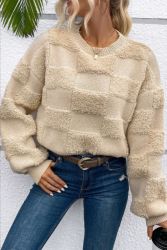Date: 24 Jul 2025
1. Measure your main body dimensions accurately
Why it matters:
Every person has unique proportions. Size S or M can vary from brand to brand. The safest way to reduce mistakes is to know your exact body measurements.
What to measure:
-
Bust: measure around the fullest part of your chest.
-
Waist: measure around the narrowest part of your torso.
-
Hips: measure around the widest part of your hips.
-
Inseam length: if ordering trousers, measure from the inside of your thigh down to the ankle.
-
Sleeve length: if ordering a shirt or jacket, measure from the shoulder to the wrist.
How to measure correctly:
Use a soft measuring tape, not a metal one. Take measurements over underwear or a thin layer of clothing so you don’t add extra centimeters. Don’t pull the tape too tight, but don’t leave it loose either. Stand in front of a mirror or ask someone to help to make sure the tape is straight. Write down your results in a note or on your phone so you always have them on hand.
How to make it a habit:
Keep your measuring tape in the drawer with your clothes. Whenever you decide to shop online, check your saved measurements first and update them if needed.
2. Compare your measurements with the size chart on the website
Why it matters:
Every manufacturer uses different standards. What is M for one brand might be S or L for another. The size chart is your guide.
What to do:
-
Open the size chart on the website. It’s usually in the product description or on a separate page.
-
Find the columns for bust, waist and hips and compare them with your own measurements.
-
If you’re between two sizes, think about how you want the garment to fit – more fitted or more relaxed.
Example:
If your bust is 92 cm and the chart says:
S – 88–92 cm
M – 93–97 cm
L – 98–103 cm
then you are right on the border between S and M – if you want a tighter fit, choose S, and if you want a bit more freedom, choose M.
Helpful tips:
-
If the garment is made from stretchy fabric, you can choose the smaller size for a more fitted look.
-
If it’s a rigid fabric without stretch, it’s safer to go for the larger size so it’s not too tight.
-
Check if the website includes notes like “Runs small” or “Relaxed fit.”
3. Pay attention to the cut and the fabric
Why it matters:
Two garments with the same size can look completely different depending on the cut and the fabric.
Fitted, straight, oversize – what they mean:
-
Fitted cut: the garment is designed to follow the shape of the body. Often used for dresses, blazers and blouses for formal occasions.
-
Straight cut: falls loosely without narrowing at the waist. Great for everyday wear where comfort is key.
-
Oversize: deliberately wider and looser for a modern, relaxed silhouette.
Fabric makes a difference:
-
Stretchy fabrics (cotton with elastane, viscose) are forgiving with small size differences.
-
Non‑stretch fabrics (linen, silk, stiff cotton) require very precise sizing.
-
Some fabrics shrink slightly on the first wash – for example linen or pure cotton. Always read the care instructions in the description.
How to apply this:
When choosing a garment, don’t focus only on the size, look at the cut. If you need something more elegant for the office, a fitted cut is your best choice. If you want something for casual wear – look for a straight or oversize fit to feel comfortable.
4. Examine the details and photos
Why it matters:
Photos give you information that’s not always described in words.
What to look at:
-
Zoom in on the photos and check the seams, hems and closures.
-
Look for photos where the model’s height and size are given – this helps you see how it fits on different body types.
-
Observe how the fabric drapes – heavier fabric hangs straighter, lighter fabric moves and shapes more easily.
-
If there are photos from different angles, compare the back and front lengths.
Helpful habit:
Before you click “Buy,” spend a couple of minutes looking at every photo and imagining how that cut will look on you.
5. Check the return policy
Why it matters:
No one is immune to mistakes. It’s important to know what to do if the size doesn’t fit.
What to do:
-
Carefully read the website’s return policy – deadlines, garment condition, and required documents.
-
Keep the original packaging and tags until you’re sure you’re keeping the item.
-
Check who covers the return shipping.
-
If you’re unsure about the size, contact the support team and ask for advice before ordering rather than dealing with returns later.
Summary
Choosing the right clothing size online isn’t difficult if you approach it prepared.
– Measure your body carefully and write down your numbers.
– Compare them with the size chart on the website.
– Pay attention to the cut – fitted, straight or oversize – and the fabric.
– Look closely at the photos to see how the fabric falls and how the garment fits.
– Finally, check the return policy so you can feel confident.
With these steps, you’ll shop for clothes online with confidence, avoid disappointments and enjoy your new finds from the very first wear.







